Students get through AP Inter 1st Year Botany Important Questions 12th Lesson Histology and Anatomy of Flowering Plants which are most likely to be asked in the exam.
AP Inter 1st Year Botany Important Questions 12th Lesson Histology and Anatomy of Flowering Plants
Very Short Answer Questions
Question 1.
The transverse section ofa plant material shows the following anatomical features- a. the vascular bundles are conjoint, scattered and surrounded by a sclerenchymatous bundle sheaths, b. Phloem parenchyma is absent. What will you identify it as?
Answer:
Monocot stem
Question 2.
Why are xyleni and phloem called complex tissues?
Answer:
Xylem and phloem are permanent tissues having more than one type of cells and work together as a unit. So they are called complex tissues.
![]()
Question 3.
How is the study of plant anatomy useful to us?
Answer:
- Plant anatomy is useful to understand the internal structure and arrangement of various tissues of plants.
- It is useful to understand various plant diseases and their cure.
Question 4.
Protoxylem is the first formed xylem. If the protoxylem lies radially next to phloem. What kind of arrangement of xylem would you call it? Where do you find it/
Answer:
a) Radial vascular bundle b) They are found in roots.
Question 5.
What is the function of phloem parenchyma?
Answer:
Phloem parenchyma stores food materials and other excretory substances like gums, resins, latex and mucilage.
Question 6.
a) What is present on the surface of the leaves which helps the plant to prevent loss of water but is absent in roots?
b) What is the epidermal cell modification in plants which prevents water loss?
Answer:
a) Cuticle b) Trichomes
Question 7.
Which part of the plant would show the following?
a) Radial vascular bundle
b) Polyarch xylem
c) Well developed pith
d)Exarch xylem
Answer:
a) Root
b) Monocot root
c) Monocot root
d) Root
Question 8.
What are the cells that make the leaves curl in plants during water stress? Give an example.
Answer:
Bulli form cells. Ex: Monocot leaves (Grass)
Question 9.
What constitutes the vascular cambial ring?
Answer:
Intrafascicular cambium and Interfascicular cambium constitutes cambial ring.
Question 10.
Give one basic functional difference between phellogen and phelloderm.
Answer:
- Phellogen is the cork cambium which is a meristematic tissue.
- Phelloderm is the secondary cortex which is a permanent tissue.
Question 11.
If one debarks a tree, what parts of the plant are removed?
Answer:
All the tissues outside the vascular cambium are removed i.e., periderm and secondary phloem are removed.
Short Answer Questions
Question 1.
State the location and function of different types of meristems. [TS M-15, 16, 17, 19] [AP M-20]
Answer:
Based on the location, Meristems are three types.
They are
- Apical
- Intercalary
- Lateral Meristems.
1) Apical meristems: These are present at the growing tips of roots, stems, branches etc. They help in linear growth of the plant body. They appear early in the life of a plant and contribute to the formation of the primary plant body. So they are called primary meristems.
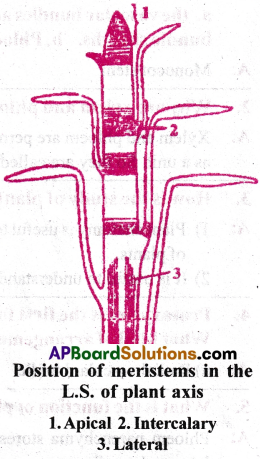
2) Intercalary meristems: These are found in between the permanent tissues. They are seen at the base of intemodes and leaf bases of monocotyledons, particularly grasses. They are active for a short period and gradually change into permanent tissues. These are also primary meristems.
3) Lateral meristems: They are present at the lateral sides of the plant body. The cells help to increase the thickness of the organs like stem and root. It helps in the secondary growth. Ex: Vascular cambium
![]()
Question 2.
Cut a transverse section of young stem of a plant from your garden and observe it under the microscope. How would you ascertain whether it is a monocot stem or a dicot stem? Give reason.
Answer:
Based on the following differences we can ascertain whether the given stem is monocot or dicot.
Monocot stem
- Trichomes are absent.
- Cortex is highly reduced.
- Hypodermis is sclerenchymatous.
- Endodermis is absent.
- Pericycle is absent.
- Vascular bundles are numerous.
- Vascular bundles are oval shaped.
- Vascular bundle is enclosed by fibrous sheath (fibro-vascular bundle)
- Vascular bundles are closed type.
- Xylem vessels are few in number.
- Protoxylem Iacunae are absent.
- Medulla and medullary rays are present.
- Vessels are in seril order.
- Phloem parenchyma is present.
Dicot stem
- Trichomes are present
- Cortex is well developed.
- Hypodermis is collenchymatous.
- Endodermis is present as starch sheath.
- Pericycle is present.
- Vascular bundles are few in number.
- Vascular bundles are wedge shaped.
- Vascular bundle is not enclosed by fibrous sheath.
- Vascular bundles are open type.
- Xylem vessels are more in number.
- Protoxylem lacunae are absent.
- Medulla and medullary rays are present.
- Vessels are in serial order.
- Phloem parenchyma is present.
Question 3.
What is periderm? How does periderm formation take place in the dieot stems? [AP, TS M-18]
Answer:
Periderm: The corkey outer layer of a plant system formed as a secondary covering in response to injury or infection is called Periderm.
Periderm formation:
- Due to the activity of vascular cambium, the stem continues to increase the girth.
- The outer cortical cells and epidermal layers get broken.
- They are to be replaced by new protective layers.
- The phellogen (or cork cambium) develops in the cortical region with two layers thick.
- The outer cells differentiate into cork or phellem.
- The inner cells differentiate into secondary cortex or phelloderm.
- The phellogen, phellem and phelloderm collectively form periderm.
- Here and there, on the periderm aerating pores called lenticells are formed for gaseous exchange.
Question 4.
A transverse section of the trunk of a tree shows concentric rings which are known as annual rings. How are these rings formed? What is the significance of these rings?
Answer:
- In temperate region, the activity of the cambium is influenced by the seasonal variation.
- During spring season, more leaves and flowers are formed.
- The plant requires more water and mineral salts.
- Hence the wood formed in this period shows more number of xylem vessels having wider lumens.
- This is known as spring wood or early wood.
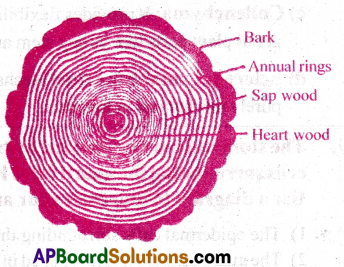
- During autumn, the plants donot require much water.
- Hence the wood produced in this period shows less number of xylem vessels having narrow lumens.
- This is known as autumn wood or late wood.
- In this way, two types of secondary xylem are produced in ‘one year’.
- They appear as circles. These are called growth rings or annual rings.
- By counting the number of annual rings, the approximate age of a tree can be estimated.
- This branch of science is called Dendrochronology.
Question 5.
What is the difference between lenticels and stomata? [AP M-19] [AP, TS Mar, May-17]
Answer:
Question 6.
Write the precise function of
a) Sieve tube b) interfasicular cambium c) Collenchyma d) Sclerenchyma
Answer:
a) Sieve tube: The precise function of sieve tube is to transport organic food materials from leaves to other parts of plant body.
b) I nterfasicular cambium: It helps in formation of complete ring of vascular cambium along with intrafasicular cambial strips. The vascular cambium thus formed helps in intrastelar secondary growth.
c) Collenchyma: It provides flexibility and tensile strength with mechanical strength in young aerial plant parts like young stem and petiole of leaf.
d) Sclerenchyma: It is a dead mechanical tissue. It gives tensile strength to the stem which is purely mechanical in function.
![]()
Question 7.
The stomatal pore is guarded by two kidney shaped guard ceils. Name the epidermal cells surrounding the guard cells. How does a guard cell differ from an epidermal cell? Use a diagram to illustrate your answer.
Answer:
- The epidermal cells surrounding the guard cells are subsidiary cells or accessory cells.
- The guard cells are kidney shaped in dicots and dumb bell shaped in monocots. While epidermal cells are barrel shaped.
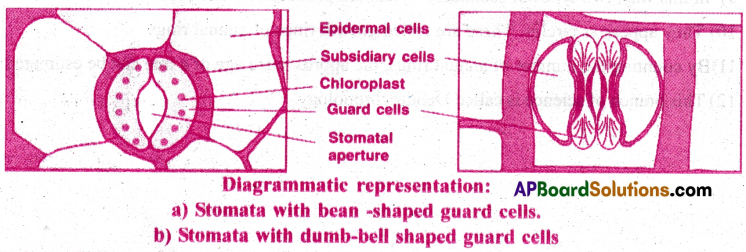
- Guard cells contain chloroplasts, unlike the epidermal cells.
- The wall of the guard cell towards the stomatal pore is thick, while its outer wall is thin.
- Guard cells possess chloroplasts whereas, epidermal cells donot possess chloroplasts.
Question 8.
Point out the differences in the anatomy of leaf of peepal (Ficus religiosa) and maize (zea mays). Draw the diagrams and label the differences.
Answer:
Dicot leaf
- Stomata are more in the lower epidermis than in the upper epidermis.
- Bulli form cells are absent.
- Mesophyll is differentiated into palisade and spongy tissues.
- Bundle sheath extensions are generally parenchymatous.
- Vascular bundles are big in the mid vein and small in the veins.
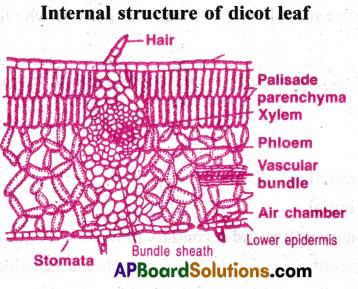
Monocot leaf
- Stomata are equally distributed on both the sides.
- Bulli-form cells are present in the upper epidermis.
- Mesophyll is undifferentiated.
- Bundle sheath extensions are generally sclerenchymatous.
- Vascular bundles are similar in size.
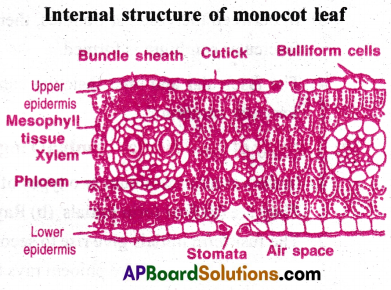
Question 9.
Cork cambium forms tissues that form the cork. Do you agree with this statement? Explain.
Answer:
Yes. Cork cambium is a secondary meristematic tissue. It is of two layered thickness. It has the capacity to divide. It cuts off cells on both the sides. The outer cells differentiate into cork or phellem. The inner cells differentiate into secondary cortex or phelloderm.
![]()
Question 10.
Name the three basic tissue systems in the flowering plants. Give the tissue names under each system.
Answer:
On the basis of structure and location, there are three types of tissue systems.
They are
- Epidermal tissue system
- Ground tissue system and
- vascular tissue system.
Epidermal tissue system consists of parenchymatous tissue. They are epidermis, stomata and the epidermal out growths like trichomes and hairs.
Ground tissue system consists of simple tissues like parenchyma, collenchyma and sclerenchyma.
Vascular tissue system consists of complex tissues, the phloem and xyiem.
Long Answer Questions
Question 1.
Explain the process of secondary growth in the stems of woody angiosperms with the help of schematic diagrams. What is its significance?
Answer:
The process of secondary growth occur in two steps:
I) Intra stelar secondary growth. II) Extra stelar secondary growth
I) Intra stelar secondary growth: These are the changes that occur inside the stelar region. They occur in two stages.
a) Formation of vascular cambium ring:
- In the primary dicot stem, the stele shows vascular bundles in the form of a circle.
- Each bundle consists of cambium in between the xylem and phloem. This is called fascicular cambium.
- In between the vascular bundles, there are medullary rays, from the cells of which inter fascicular cambium is formed.
- The fascicular and inter fasicular cambia fuse to form a continuous cambial ring called ‘vascular cambium’.
b) Activity of the vascular cambial ring:
- In the vascular cambium two types of initiating cells are formed.
They are (a) Fusi form initials (b) Ray initial. - The fusi form initials give rise to secondary xylem and secondary phloem.
- The ray initials produce phloem rays towards outside and xylem rays towards inside.
- As the stem increases in thickness, the primary phloem and primary xylem are crushed and removed.
- They are soon replaced by secondary phloem (bast) and secondary xylem (wood). The quantity of wood is more in comparison to bast.
II) Extra stelar secondary growth: These are the changes that occur outside the stelar region.
- As the secondary phloem and secondary’ xylem are formed inside the stele, pressure is exerted on the epidermis, causing its rupture.
- Meanwhile secondary protective layer called periderm is formed in the cortex.
- The secondary growth in cortex begins with the appearance of meristematic layer of cells of cells from the middle part of cortex.
- This is called phellogen or cork cambium.
- The cells of phellogen divide periclinally and cuts of new cells on either side.
- The tissue produced on the outside is called cork or phellem.
- The tissue produced to the inside is called secondary cortex or phelloderm.
- Phellogen, phellem and phelloderm are together known as periderm.
- Aerating pores are developed on the periderm at some intervals.
- They facilitate gaseous exchange to the tissues of old stem.
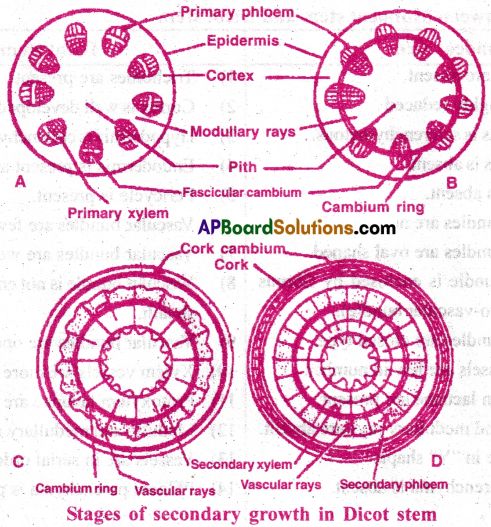
Question 2.
Draw illustrations to bring out the anatomical differences between a. Monocot root and Dicot root
b. Monocot stem and Dicot stema.
Answer:
Monocot root
- Pericycle produces only lateral roots.
- Vascular bundles are more than six.
- Pith is large and well developed.
- Secondary growth is absent.
- Cortex is big.
- Medulla is very big.

Dicot root
- Pericycle produces lateral roots & vascular cambium during secondary growth.
- Vascular bundles range from two to four.
- Pith is small or inconcspicuous.
- Secondary growth is present.
- Cortex is relatively smaller.
- Medulla is very small or absent.

![]()
b. Differences between Monocot stem and Dicot stema.
Monocot stem
- Trichomes are absent.
- Cortex is highly reduced.
- Hypodermis is sclerenchymatous.
- Endodermis is absent.
- Pericycle is absent.
- Vascular bundles are numerous.
- Vascular bundles are oval shaped.
- Vascular bundle is enclosed by fibrous sheath (fibro-vascular bundle).
- Vascular bundles are closed type.
- Xylem vessels are few in number.
- Protoxylem lacunae are present.
- Medulla and medullary rays are absent.
- Vessels are in “Y” shape.
- Phloem parenchyma is absent.
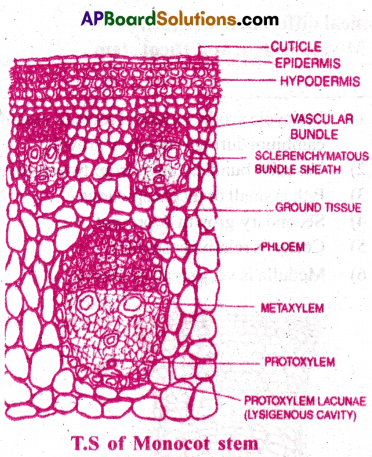
Dicot stem
- Trichomes are present
- Cortex is well developed.
- Hypodermis is collenchymatous.
- Endodermis is present as starch sheath.
- Pericycle is present.
- Vascular bundles are few in number.
- Vascular bundles are wedge shaped.
- Vascular bundle is not enclosed by fibrous sheath.
- Vascular bundles are open type.
- Xylem vessels are more in number.
- Protoxylem lacunae are absent.
- Medulla and medullary rays are present.
- Vessels are in serial order.
- Phloem parenchyma is present.

Question 3.
What are simple tissues? Describe various types of simple tissues.
Answer:
Simple Tissues: Tissues which are made up of only one type of cells are called simple tissues.
The various simple tissues in plants are parenchyma, collenchyma and sclerenchyma.
a) Parenchyma:
- Parenchyma forms major component of plant organs.
- Cells of parenchyma are spherical, oval, round or polygonal.
- Their walls are thin and made up of cellulose.
- They may be closely packed or have small inter cellular spaces.
- Parenchyma performs photosynthesis, storage and secretion.
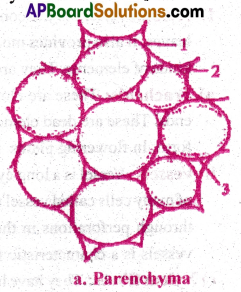
b) Collenchyma:
- Collenchyma occurs in layers below the epidermis in dicot stem, petiole and pedicels.
- It occurs as a homogenous layer or in patches.
- The cells are thick at the comers due to a deposition of pectin, cellulose and hemicellulose.
- Cells may be oval, spherical or polygonal in shape.
- Inter cellular spaces are absent.
- Contain chloroplasts and perform photosynthesis.
- They allow bending movements in young stems, petiole of leaves.
- Thus they are providing mechanical strength to young stem, petiole of leaf.
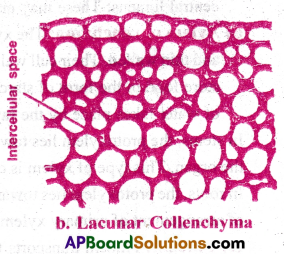
c) Sclerenchyma:
- It is a dead mechanical tissue with lignified cell walls.
- Based on the structure and origin, sclerenchyma may be either fibres or sclerides.
- The fibres are thick walled, elongated and pointed cells, occur in groups.
- Sclerides are spherical or oval or cylindrical, highly thickened dead cells with narrow lumen.
- These are commonly found in Suit walls of nuts, sead coat of legumes and pulp of fruits like guava.
- Sclerenchyma provides mechanical support to plant organs.
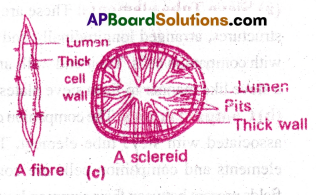
Question 4.
What are complex tissues? Describe various types of complex tissues. [TS M -19]
Answer:
Complex tissues: Tissues which are made up of more than one type of cells and work together as a unit are called complex tissues. They are of two types Xylem and Phloem.
I) Xylem: Xylem is the conducting tissue for water and minerals from roots to the stem and leaves. It also provides mechanical strength to the plant parts. It is composed of four different kinds of elements. They are (a) tracheids (b) vessels (c) xylem fibres (d) xylem parenchyma.
a) Tracheids: These are elongated tube like cells with thick and lignified walls and tapering ends. These are dead elements. The inner layers of cell walls have thickenings which vary in form. In flowering plants, tracheids and vessels are the main transporting elements.
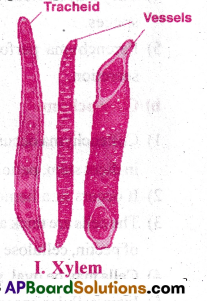
b) Vessels: Vessel is a long cylindrical tube like structure made up of many cells called vessel members. Vessels are inter connected through perforations in their common walls. The presence of vessels is a characteristic feature of angiosperms.
c) Xylem fibres: They have highly thickened walls and obliterated central lumens. These may either be septate or aseptate.
d) Xylem parenchyma: The xylem parenchyma cells are living and thin walled. Their cell walls are made up of cellulose. They store food in the form of starch and fat. The radial conduction of water takes place by the ray -parenchymatous cells.
In stems, the protoxylem lies towards the centre and metaxylem lies towards the periphery of the organ. This type of xylem is called ‘endarch’.
In roots, the protoxylem lies towards periphery and metaxylem lies towards the centre. This type of arrangement of primary xylem is called ‘exarch’.
II) Phloem: Phloem transports food materials from the leaves to other parts of the plant. Phloem in angiosperms is composed of sieve tube elements, companion cells, phloem parenchyma and phloem fibres.
(a) Sieve Tube elements: These are long tube like structures, arranged longitudinally and are associated with companion cells. Their end walls are perforated in a sieve like manner to form sieve plates.
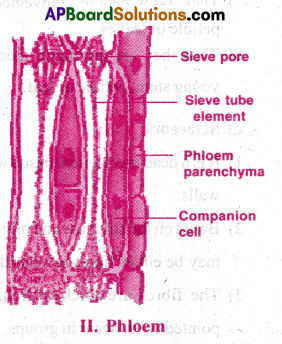
(b) Companion cells: The companion cells are closely associated with sieve tube element. The sieve tube elements and companion cells are connected by pit fields present between their common longitudinal walls.
(c) Phloem parenchyma: It is made up of elongated, tapering cylindrical cells with dense cycloplasm and nucleus. They store food material, resin and letex.
(d) Phloem fibres (bast fibres): They are made up of sclerenchymatous cells. They are elongated, pointed and needle like. At maturity, these fibres lose their protoplasm and become dead.
![]()
Question 5.
Describe the internal structure of dorsiventral leaf with the help of labelled diagram.
Answer:
T.S (Transverse Section) of dorsiventral leaf (dicot leaf) shows three main parts.
They are I) Epidermis II) Mesophyll III) Vascular bundles. [TS Mar-17, 20] [AP Mar-19]
I) Epidermis:
- It consists of the upper surface and lower surface of the leaf.
- It is madeup of single layered, rectangular, compactly arranged cells.
- It contains epidermal hairs(trichomes).
- Thick cuticle is present in upper surface and thin cuticle in lower surface.
- Stomata are present mostly on lower epidermis. They help in transpiration.
- Epidermis gives protection to the inner tissues and helps in gaseous exchange.
II) Mesophyll:
- Mesophyll tissue is present between the upper and lower epidermis.
- It is divided into upper palisade parenchyma and lower spongy parenchyma.
- Palisade parenchyma consists of vertically, elongated cells arranged in two layers.
- Spongy parenchyma consists of loosely arranged oval shaped cells.
- Mesophyll cells contain chloroplasts. They perform photosynthesis.
- Mesophyll helps in the synthesis of food.
III. Vascular Bundles:
- Vascular bundles are present in the mid vein region of mesophyll tissue.
- They are conjoint, collateral and closed.
- Each vascular bundle is surrounded by a bundle sheath.
- Xylem lies towards the upper epidermis and phloem lies towards the lower epidermis.
- Vascular bundles help in supplying water, mineral salts and food material.

Question 6.
Describe the internal structure of an isobilateral leaf with the help of labelled diagram.
Answer:
T.S (Transverse Section) of isobilateral leaf shows three main parts.
They are I) Epidermis II) Mesophyll III) Vascular bundles.
1) Epidermis:
- It consists of the upper surface and lower surface of the leaf.
- It is madeup of single layered, rectangular, compactly arranged cells.
- It does not contain epidermal hairs(trichomes). .
- Thick cuticle is present on both the upper and lower surfaces.
- Stomata are present on both surfaces. They help in transpiration.
- Epidermis gives protection to the inner tissues and helps in gaseous exchange.
- In grasses, bulliform cells are present. They help in folding of the leaves.
II) Mesophyll:
- Mesophyll tissue is present between the upper and lower epidermis.
- It is not divided into palisade and spongy parenchyma.
- Entire mesophyll is made up of spongy parenchyma cells.
- Mesophyll is loosely arranged with many intercellular spaces.
- Mesophyll cells contain chloroplasts.They perform photosynthesis.
- Mesophyll helps in the synthesis of food.
III) Vascular Bundles:
- Numerous vascular bundles are present parallely in the mesophyll.
- They are conjoint, collateral and closed.
- Each vascular bundle is enclosed by bundle sheath.
- Xylem lies towards upper epidermis and phloem lies towards lower epidermis.
- Vascular bundles help in supplying water, mineral salts and food material.
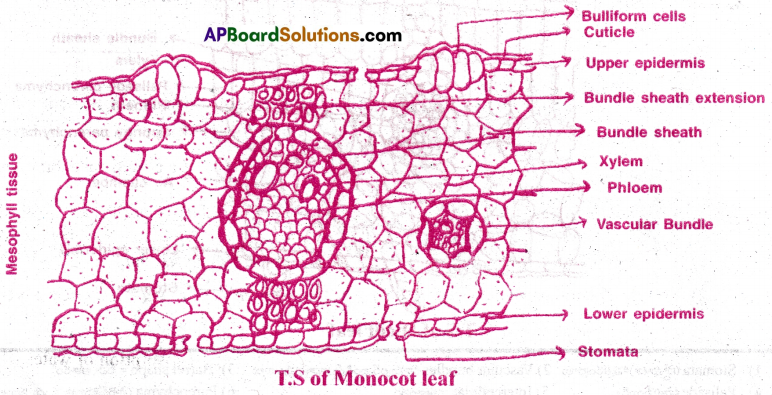
Question 7.
Distinguish between the following:
a) Exarch and endarch condition of protoxylem
b) Steie and vascular bundle,
c) Protoxylem and metaxylem
d) Interfasicuiar cambium and intrafasicular cambium
e) Open and closed vascular bundles,
f) Stem hair and root hair
g) Heart wood and sap wood
h) Spring wood and Autumn wood.
Answer:
| a) Exarch | Endarch |
| The protoxylem lies towards the periphery and mataxylem lies towards the centre. Ex: Root | The protoxylem lies towards the center (pith) and the metaxylem lies towards the periphery (pericycle).Ex: Stem |
| b) Stele | Vascular bundle |
| It is the central conduction cylinder consisting pericycle, vascular bundles, pith or medulla and medullary rays. | It is a strand of central conduction cylinder or stele consisting xylem bundles and phloem bundles. |
| c) Protoxylem | Metaxylem |
| 1) The first formed primary xylem elements are called protoxylem 2)>They have narrow lumen |
1) Later formed primary xylem elements are called metaxylem. 2) They have wider lumen. |
| d) Interfasicuiar Cambium | Intrafasicular cambium |
| 1) A few cells of the medullary rays, present opposite to the intra fasicular cambium become meristematic and is known as interfasicuiar cambium. 2) It is the tissue present in between the vascular bundles. |
1) The cambium present in between the primary xylem and primary phloem of a vascular bundle is called intra fasicular cambium. 2) It is present with in a vascular bundle. |
| e) Open vascular bundle | Closed vascular bundle |
| 1) If there is a cambium between xylem and phloem of a vascular bundle. 2) It is said to be open vascular bundle |
1) If the cambium is not present between xylem and phloem of a vascular bundle, 2) It is said to be a closed vascular bundle. |
| f) Stem hair | Root hair |
| 1) They are multicellular 2) The epidermal surface is covered by cuticle. 3) They check the rate of transpiration. |
1) These are unicellular. 2) The epidermal surface is not covered by cuticle. 3) They help in absorption of water from the soil. |
| g) Heart wood | Sap wood |
| 1) Constitutes greater part of secondary xylem. 2) It does not conduct water. 3) It is highly durable. 4) It is older and harder part. |
1) Constitutes relatively lesser part of secondary xylem. 2) It is active in conduction water. 3) It is less Durable and more permeable. 4) It is younger and softer part. |
| h) Spring wood | Autumn wood |
| 1) Xylem formed in springs season and have wider lumes is called spring wood. 2) It is light in colour. 3) It is formed early in a year. 4) Produced more in amount. 5) Xylem vessels have wide lumens. |
1) Xylem formed in autumns season with narrow lumen is called Autumn wood. 2) It is dark in colour. 3) It is formed after the early wood. 4) Produced less in amount. 5) Xylem vessels have narrow lumens. |
![]()
Question 8.
What is stomatal apparatus? Describe the structure of stomata with a labeled diagram.
Answer:
Stomatal apparatus: The stomatal opening, guard cells and the surrounding subsidiary cells are together called stomatal apparatus.
Structure of stomata:
- Stomata are the openings present in the epidermis of leaves.
- Stomata are more on the lower surface and less on the upper surface of dicot leaves,
- Stomata are equal number on both the surfaces of monocot leaves.
- Each stomata is composed of bean-shaped cells known as guard cells.
- In grasses, the guard cells are dumb-bell shaped.
- The outer walls of guard cells are thin and inner walls are highly thickened.
- The guard cells possess chloroplasts and regulate the opening and closing of stomata.
- The epidermal cells surrounding the guard cells are known as subsidiary cells.

Question 9.
Describe the T.S of a Dicot Stem.
Answer:
T.S of young dicot stem shows three main parts. They are I) Epidermis II) Cortex III) Stele
I) Epidermis:
- It is the outermost layer.
- It is madeup of single layered rectangular cells.
- It contains epidermal hairs(trichomes).
- Thin cuticle is present.
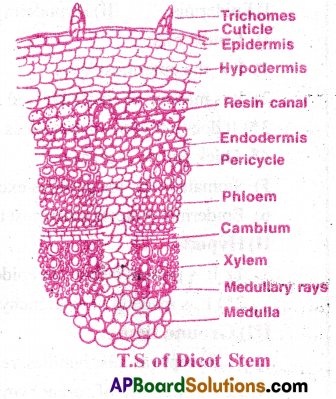
- Stomata helps for gaseous exchange.
- Epidermis protects innermost tissues.
II) Cortex: The part between epidermis and stele is called cortex. It has three subzones
a) Hypodermis:
- Hypodermis is present below the epidermis
- It is madeup of collenchyma.
- It gives mechanical strength to the stem.
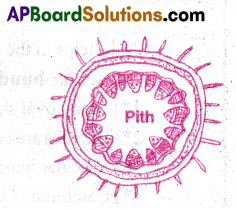
b) Parenchyma) General Cortex):
- It is found below the hypodermis and is made up of thin walled parenchyma.
- They enclose a number of glands.
c) Endodermis:
- Inner most layer of cortex is called endodermis.
- The cells are barrel shaped; compactly arranged without any intercellular spaces.
- These cells contain starch grains. Hence, it is known as ‘starch sheath’.
- The radial walls show lens shaped thickenings called casparian bands.
III) Stele: Stele is the central conducting cylinder
It has four parts (a) pericycle (b) vascular bundles (c) medulla (d) Medullary rays.
a) Pericycle: Pericycle is with single layer of cells surrounding the stele.
b) Vascular bundles:
- Few number (7-15) of Vascular bundles are present in stele.
- Each vascular bundle is wedge shaped, conjoint, collateral, open.
- Each vascular bundle is enclosed by bundle sheath.
- In between the phloem and xyiem, cambium is present.
c) Medulla(pith):
- Medula is the central part of stele
- It helps in storage.
d) Medullary rays:
- The cells between vascular bundles look like rays radiating irwn.
- They help in lateral conduction of food.
Question 10.
Describe the T.S of Monocot Stem.
Answer:
T.S of Monocot Stem shows Four main parts. They are
I) Epidennis II) Hypodermis III) Ground tissues IV) Vascular bundles.
I) Epidermis:
- It is the outermost layer
- It is madeup of single layered, rectangular cells.
- It does not contain trichomes.
- Thick cuticle is present.
- Stomata helps for gaseous exchange.
- Epidermis protects innermost tissues.
II) Hypodermis:
- It is present below the epidermis.
- It is madeup of sclerenchyma and gives mechanical strength to the stem.
III) Ground tissue:
- Except vascular bundles, remaining portion is called Ground Tissue
- It is madeup of parenchyma
- It helps in the storage of food.
IV) Vascular bundles:
- Many oval shaped vascular bundles are scattered in the ground tissue.
- Bundles are conjoint, collateral, closed.
- Vascular bundles are surrounded by bundle sheath
- Cambium is absent.

Question 11.
Describe the internal structure of a Dicot Root.
Answer:
T.S of Dicot Root shows three main parts. They are I. Epidermis II. Cortex III. Stele
I) Epidermis:
- It is the outermost layer
- It is madeup of single layered rectangular cells.
- It contains root hairs. They help in absorption of water.
- Cuticle and stomata are absent.
- Epidermis is useful in the protection of inner tissue.
II) Cortex:
The Region between epidermis and stele is called cortex. It has three subparts.
a) Exodermis:
- It is 2 to 3 layered thick suberised cells.
- It prevents the exit of water from cortex.

b) Parenchymal Genera! Cortex):
- It is found below the.hypodermis and is made up of thin walled parenchyma.
- They enclose a number of glands.
c) Endodermis:
- It is the inner most layer of the cortex.
- Cylindrical cells are tightly arranged.
- Endodermis contains ‘casparian thickenings’.
![]()
III) Stele:
- Stele is the central conducting cylinder.
- It has three parts (a) Pericycle (b) Vascular bundles (c) Medulla
a) Pericycle:
- Pericycle is with single layer of cells surrounding the stele.
- Lateral roots originate from pericycle cells.Secondary growth is observed .
b) Vascular bundles:
- Vascular bundles contain xylem and phloem on separate radii.
- Usually 4 xylem bundles alternate with 4 phloem bundles.
- This condition is called ‘Tetrach’.
- Xylem transports water. Phloem transports food.
c) Medulla (or) Pith :
- Medulla is small (or) absent.
- It helps in the storage of food and water.
Question 12.
Describe the internal structure of a Monocot Root. [AP M-20] [AP, TS May-17|
Answer:
T.S of Monocot Root shows three main parts.

They are I) Epidermis II) Cortex III) Stele.
1) Epidermis:
- It is the outermost layer
- It is madeup of single layered rectangular cells.
- It contains root hairs. They help in absorption of water.
- Cuticle and stomata are absent
- Epidermis is useful in the protection of inner tissue.
II) Cortex:
The Region between epidermis and stele is called cortex. It has three subparts.
a) Exodermis:
- It is 2 to 3 layered thick suberised cells
- It prevents the exit of water from corte:
b) Parenchymal General Cortex):
- It is found below the hypodermis and is made up of thin walled parenchyma.
- They enclose a number of glands.
c) Endodermis:
- It is the inner most layer of the cortex.
- Cylindrical cells are tightly arranged.
- Endodermis contains ‘casparian thickenings’.
III) Stele:
- Stele is the central conducting cylinder.
- It has three parts (a) Pericycle (b) Vascular bundles (c) Medulla
a) Pericycle:
- Pericycle is with single layer of cells surrounding the stele.
- Lateral roots orignate from pericycle cells. No secondary growth is observed.
b) Vascular bundles:
- Vascular bundles contain xylem and phloem on separate radii.
- Number of bundles vary from 6 to 8.
- It is called ‘Polyarch’.
- Xylem transports water. Phloem transports food.
c) Medulla (or) Pith:
- Medulla is well developed and is made up of parenchyma.
- It helps in the storage of food and water.
Exercise
Question 1.
Name the various kinds of cell layers which constitute the bark.
Answer:
Periderm and Secondary Phloem
Question 2.
A student estimated the age of a tree to be about 300 years. How did he anatomically estimate the age of this tree?
Answer:
By counting the number of annual rings, the age of the tree can be estimated.
This subject is called ‘Dendrochronology’.
![]()
Question 3.
Assume that you have removed the duramen part of a tree. Will the tree survive or die?
Answer:
- In old stem, the central dark coloured wood is called “heart wood or duramen”.
- The peripheral light coloured wood is called “Sap wood or alburnum”.
- Alburnum is meant for active conduction of water.
- Duramen is not useful for conduction of water.
- So if the duramen is removed, there is no effect to water conduction and the tree survives without any effect.
Multiple Choice Questions
Question 1.
A trichome is ………..
1. unicellular hair of stem
2. multicellular hair of stem
3. absorptive in function
4. non cuticularised
Answer:
3. absorptive in function
Question 2.
Bundle sheath as not found around the vascular bundles of
1. Monocot stem
2. Monocot root
3. Dicot leaf
4. Monocot leaf
Answer:
2. Monocot root
Question 3.
Conjunctive tissue helps in
1. Storage of food
2. Synthesis of carbohydrates
3. Conduction of mineral salts
4. Giving mechanical strength
Answer:
1. Storage of food
Question 4.
De-differentiation of cells is the cause of formation of
1. Primary meristems
2. Secondary meristems
3. Apical meristems
4. Intercalary meristems
Answer:
2. Secondary meristems
Question 5.
Epithelium is
1. A protective layer around the dead cell
2. Loose mass of parenchyma cells in a lenticel
3. A layer of secretory cells present around the schizogenous cavity
4. A layer of cells around the vascular bundle
Answer:
3. A layer of secretory cells present around the schizogenous cavity
Question 6.
Roots hairs are
1) Unicellular branched
2) Unicellular unbranched
3) Multicellular uniseriated
4) Multicellular multiseriated
Answer:
2) Unicellular unbranched
![]()
Question 7.
The main function of trichomes is
1) Prevention of loss of water
2) Opening of stomata
3) Protection form herbivores
4) Absorption
Answer:
1) Prevention of loss of water
Question 8.
Scat of the origin of lateral roots is
1) Endodermal cells
2) Pericycle cells
3) Cortical cells
4) Epidermal cells
Answer:
2) Pericycle cells
Question 9.
Lcnticcls help in
1) Transpiration only
2) Photosynthesis – gaseous exchange
3) Respiration – gaseous exchange only
4) Respiration and Transpiration
Answer:
4) Respiration and Transpiration
Question 10.
In dicot roots, the vascular cambium is derived from
1) Cortex
2) Pericycle
3) Medulla
4) Endodermis
Answer:
2) Pericycle
Question 11.
In monocot stems, each vascular bundle is surrounded by
1) Parenchymatous sheath
2) Collenchymatous sheath
3) Sclerenchymatous sheath
4) None
Answer:
3) Sclerenchymatous sheath
Question 12.
Hypodermis in primary dicot stem is made up of
1) Few layer sclerenchyma
2) Few layered collenchyma
3) Multilayered parenchyma
4) Multilayered sclerenchyma
Answer:
2) Few layered collenchyma
Question 13.
Barrel shaped cells are associated with
1) Endodermis of dicot root
2) Endodermis of monocot stem
3) Pericycle of dicot root
4) Pericycle of monocot root
Answer:
1) Endodermis of dicot root
Question 14.
Bark includes
1. Phellemandphellogen
2. Phelloderm and vascular cambium
3. All tissues outer to the vascular cambium
4. Vascular cambium and secondary phloem
Answer:
3. All tissues outer to the vascular cambium
Question 15.
Secondary meristems are found in
1. Mature parts
2. Growing tips of main stem
3. In between mature tissue
4. Rootapex
Answer:
1. Mature parts
Question 16.
Sclerenchyma differs from parenchyma in
1. having thick lignified walls
2. possessing protoplasts
3. having a central vacuole
4. showing secretory functions
Answer:
1. having thick lignified walls
![]()
Question 17.
In plants, growth occurs in
1. Vascular tissues
2. Storage tissues
3. Meristematic tissues
4. Reproductive organs
Answer:
3. Meristematic tissues
Question 18.
In xylem, the main elements of conduction are
1. Xylem fibres and tracheids
2. Vessels and xylem parenchyma
3. Tracheids and vessels
4. Xylem fibres and xylem parenchyma
Answer:
3. Tracheids and vessels
Question 19.
The function of ray parenchyma in xylem is
1. storage of Water
2.upward conduction of water
3. downward conduction of water
4. radial conduction of water
Answer:
4. radial conduction of water
Question 20.
Identify the non lignified element
1. tracheid
2. albuminous cell
3. vessel
4. fibre cell
Answer:
2. albuminous cell
Question 21.
Stomata regulate
1. transpiration
2. photosynthesis
3. respiration
4. osmotic phenomena
Answer:
1. transpiration
Question 22.
Mesophyll is a type of
1. sclerenchyma
2. collenchyma
3. parenchyma
4. meristem
Answer:
3. parenchyma
Question 23.
Ground tissue is composed of the following except
1. cortex
2. endodermis
3. phloem
4. pith
Answer:
3. phloem
Question 24.
Endodcrmis is a part of
1. outer cortex
2. vascular tissue
3. inner cortex
4. hypodermis
Answer:
3. inner cortex
Question 25.
A characterstic feature of monocot root is
1. endarch primary xylem
2. polyarch primary xylem
3. very small pith
4. presence of secondary growth
Answer:
2. polyarch primary xylem
Question 26.
Presence of lysigcnohs cavities inside the xyleni is a charecterislic feature of
1. Dicot stem
2. Monocot stem
3. Dicot root
4. dicot leaf
Answer:
2. Monocot stem
![]()
Question 27.
Early wood is formed during
1. Favourable conditions
2. Leaf fall conditions
3. Active monsoons
4. Dull monsoons
Answer:
1. Favourable conditions
Question 28.
In a secondary stem which of the following tissues consitute a major bulk
1. Primary phloem
2. Primary xylem
3. Secondary phloem
4. Secondary xylem
Answer:
4. Secondary xylem
Question 29.
Heart wood is very hard and resistant to attacks from micro organisms due to the deposition of
1. Tanins, resins and gums
2. Mineral crystals and oils
3. Starches, proteins and fats
4. Enzymes, hormones, acids
Answer:
1. Tanins, resins and gums
Question 30.
The tissue which is impervious to water is
1. Phellogen
2. Phellem
3. Phelloderm
4. Secondary medullary ray
Answer:
2. Phellem
Question 31.
Periderm includes all the following excepting
1. Cork
2. Corkcambium
3. Secondary cortex
4. Secondaryphloem
Answer:
4. Secondaryphloem
Question 32.
Trichomes present on the stem epidermis
1. Promote transpiration
2. Prevent transpiration
3. Support the growth of microorganisms
4. Give strength
Answer:
2. Prevent transpiration
Question 33.
Bark differs from periderm in having a layer of
1. Phellem
2. Phellogen
3. Phelloderm
4. Bast
Answer:
1. Phellem
Question 34.
Phellogen is an example of
1. Secondary lateral meristem
2. Primary lateral meristem
3. Intercalary meristem
4. Apical meristem
Answer:
1. Secondary lateral meristem
Question 35.
Identify the living tissue from the following
1. Pericycle in dicot stem
2. Xylem
3. Cork tissue
4. Cambium
Answer:
4. Cambium
Question 36.
Which of the following is a living cell
1. Hypodermal cell of maize stem
2. Cells.of cork tissue
3. Young phloem fibre cell
4. Young xylem fibre cell
Answer:
3. Young phloem fibre cell
Question 37.
Endodermis is absent in .
1. Dicot stem
2. Monocot stem
3. Dicotroot
4. Monocot root
Answer:
2. Monocot stem
Question 38.
Bundle sheath cells are
1. Chlorophyllous
2. Thin walled
3. Non living
4. Thick walled
Answer:
4. Thick walled
Question 39.
Regulated transpiration occurs through
1. Epidermis
2. Lenticels
3. Stomata
4. Wounds
Answer:
3. Stomata
![]()
Question 40.
Meristematic tissues are found in
1. Vascular bundles of dicot stem
2. Vascular bundles of monocot stem
3. Vascular bundles of dicot leaf
4. Vascular bundles of monocot root
Answer:
1. Vascular bundles of dicot stem
Question 41.
Phcllogen is an example of
1. Primary meristem
2. Primary lateral meristem
3. Intercalary meristem
4. Secondary lateral meristem
Answer:
4. Secondary lateral meristem
Question 42.
Lateral meristcms help the plant in
1. Linear gowth
2. Radial growth
3. Horizontal growth
4. Diagonal growth
Answer:
2. Radial growth
Question 43.
Growth of flowers and fruits is initiated by
1. Apical meristems
2. Intercalary meristems
3. Lateral meristems
4. Embryonic meristems
Answer:
2. Intercalary meristems
Question 44.
A living tissue is
1. Sclerenchyma
2. Phellogen
3. Xylem
4. Cork
Answer:
2. Phellogen
Question 45.
Resin ducts of Pin us belting to ………. category:
1. Lysigenous cavity
2. Schizogenous cavity
3. Pith cavity
4. Protoxylem cavity
Answer:
2. Schizogenous cavity
Question 46.
Mechanical tissues are
1. Parenchyma and Collenchyma
2. Sclerenchyma and Collenchyma
3. Xylem and Phloem
4. Meristem and Laficiferous tissue
Answer:
2. Sclerenchyma and Collenchyma
Question 47.
Lignilied cell walls are found in
1. Aerenchyma and Chlorenchyma
2. Angular Collenchyma and Lamellar Collenchyma
3. Fibers and Sclereids
4. Tracheids and Sieve tubes
Answer:
3. Fibers and Sclereids
Question 48.
Xylent parenchyma helps the plant in
1. Conduction of water and salts vertically
2. Conduction of water and salts radially
3. Storage of starch or fat
4. Synthesis of carbophdrates
Answer:
3. Storage of starch or fat
Question 49.
Trichomes found in dicot stem are …………
1. Unicellular
2. Multicellular, uniseriate
4. Multicelluiar, multiseriate
3. Multicellular, biseriate
Answer:
3. Multicellular, biseriate
![]()
Question 50.
The function of buliform cells is
1. Regulating the opening and closure of stomata
2. Permitting the loss of water from leaf surface
3. Causes rolling and unrolling of the leaf
4. Giving protection to the inner tissues
Answer:
3. Causes rolling and unrolling of the leaf
Question 51.
The function of root hairs is
1. Absorption of water and minerals
2. Releasing secretions into soil
3. Killing the harmful micro organisms in the soil
4. Absorption of water but not minerals
Answer:
4. Absorption of water but not minerals
Question 52.
Cambium is found in
1. Monocot stem
2. Dicot stem
3. Monocot root
4. Dicot leaf
Answer:
2. Dicot stem
Question 53.
Medulla is not well developed in
1. Monocot root & Dicot stem
2. Monocot stem & Dicot root
3. Monocot stem & Monocot root
4. Dicot root & Monocot root
Answer:
2. Monocot stem & Dicot root
Question 54.
Monocot root differs from dicot root in the
1. presence of relatively bigger cortex
2. presence of tetrarch xylem
3. occurance of secondary growth
4. absence of medulla
Answer:
1. presence of relatively bigger cortex
Question 55.
The type of vascular cylinder in Helianthus stem is called
1. Atactostele
2. Dictyostele
3. Meristele
4. Eustele
Answer:
4. Eustele
Question 56.
Which of the following is present in Monocot stem
1. Phloem parenchyma
2. Medullary rays
3. Pericycle
4. Xylem parenchyma
Answer:
4. Xylem parenchyma
Question 57.
Dicot stem differs from monocot stem in character
1. Collenchymatoushypodermis
2. Sclerenchymatoushypodermis
3. Oval shaped vascular bundles
4. Presence of protoxylem lacunae
Answer:
1. Collenchymatoushypodermis
Question 58.
The guard cells in the epidermis of Helianthus leaf are
1. Spherical
2. Reniform
3. Bulliform
4. Cylindrical
Answer:
2. Reniform
Question 59.
Tissues are classified into two main groups, namely, meristematic and permanent tissues based on
1) Position and location
2) Function, position and location
3) Whether the cells being formed are capable of dividing or not
4) Structure, function position and location
Answer:
3) Whether the cells being formed are capable of dividing or not
Question 60.
Which of the following is(are) complex tissue(s)
1) Parenchyma
2) Phloem
3) Xylem
4) Both 2 and 3
Answer:
4) Both 2 and 3
Question 61.
Growth in plants is largely restricted to specialized regions of active cell division, called
1) Meristems
2) Cambium
3) Primordium
4) Permanent tissue
Answer:
1) Meristems
Question 62.
Which of the following characteristic is not found in parenchyma?
1) It forms the major component within organs
2) Their walls are thick and made up of cellulose
3) They may either be closely packed or have small intercellular spaces
4) The parenchyma performs various functions like photosynthesis, storage and secretion
Answer:
2) Their walls are thick and made up of cellulose
Question 63.
Intercalary meristem is derivative of
1) Promeristem
2) Primary meristem
3) Lateral meristem
4) Secondary meristem
Answer:
2) Primary meristem
Question 64.
The sclerenchymatous sclereids are found in
1) Fruit walls of legumes
2) Pulp of fruits like, guava, pear and sapota; leaves of tea
3) Seed coat of nuts
4) All of the above
Answer:
4) All of the above
Question 65.
The cells or tissues of plants wihich have lost the power of division are called:
1) meristematic
2) permanent
3) protoderm
4) promeristem
Answer:
2) permanent
![]()
Question 66.
Length of petiole increases by the activity of
1) Apical meristem
2) Lateral meristem
3) Intercalary meristem
4) All the above
Answer:
3) Intercalary meristem
Question 67.
Identify the plant tissue in which lignin is absent
1) Collenchyma
2) Sclerenchyma fibres
3) Sclereids
4) Xylem tracheids
Answer:
3) Sclereids
Question 68.
Which one of the following comprises only simple tissues?
1) Parenchyma, collenchyma and sclerenchyma
2) Parenchyma, xylem and collenchyma
3) Parenchyma, xylem and sclerenchyma
4) Xylem and phloem
Answer:
1) Parenchyma, collenchyma and sclerenchyma
Question 69.
Chlorenchyma cells are
1) Chlorophyll-containing sclerenchyma cells
2) Chlorophyll-containing epidermis
3) Chlorophyll-containing parenchyma
4) Chlorophyll-containing phloem
Answer:
3) Chlorophyll-containing parenchyma
Question 70.
Vessels are characteristic of
1) Angiosperms only
2) Gymnosperms only
3 ) Pteridophytes only
4) None of the above
Answer:
1) Angiosperms only
Question 71.
Which one of the following tissue does not possess living protoplasm?
1) endarch
2) diarch
3) poly arch
4) exarch
Answer:
2) diarch
![]()
Question 72.
The centrifugal arrangement of the xylem is called
1) Collenchyma
2) Sclerenchyma
3) Parenchyma
4) Parenchyma
Answer:
1) Collenchyma
Question 73.
A living component of xylem element is
1) Xylem tracheid’s
2) Xylem vessels
3) Xylem fibres
4) Xylem parenchyma
Answer:
4) Xylem parenchyma
Question 74.
Albuminous cells of gymnosperms are equivalent to
1) Seive tubes
2) Seive cells
3) Companion cells
4) Cork cambium
Answer:
3) Companion cells
Question 75.
Which are the following cells of phloem helps in maintaining “pressure gradient in sieve tubes”
1) Phloem parenchyma
2) Companion cells
3) Phloem fibres
4) Sieve cells
Answer:
2) Companion cells
Question 76.
A conjoint and open vascular bundle will be observed in the transverse section of
1) Monocot root
2) Monocot stem
3) Dicot root
4) Dicot stem
Answer:
4) Dicot stem
Question 77.
Select the correct match
1) Starch sheath – Epidermis
2) Trichoblast – Endodermis
3) Lateral conduction – Medullary rays
4) Palisade and spongy – Bundle sheath
Answer:
3) Lateral conduction – Medullary rays
![]()
Question 78.
The innermost layer of cortex shows the following distinguishing character
1) The radial walls are thickened by pecto cellulose bands
2) The transverse walls are wrapped by suberized band
3) The radial walls are thickened by cutinized band
4) The transverse walls are thickened by chitinous band
Answer:
3) The radial walls are thickened by cutinized band
Question 79.
Water containing cavity within the vascular bundle of monocot stem is
1) Mucilage canal
2) Lisogenous cavity
3) Schizogenous cavity
4) Resin duct
Answer:
2) Lisogenous cavity
Question 80.
Seat of the origin of trichomes is
1) Endodermal cells
2) Pericycle cells
3) Cortical cells
4) Epidermal cells
Answer:
4) Epidermal cells
Question 81.
Which of the following pairs show very large pith
1) Sunflower stem & maize stem
2) Sunflower stem & maize root
3) Sunflower root & maize stem
4) Maize root & sunflower root
Answer:
2) Sunflower stem & maize root
Question 82.
In xylem, the main elements of conduction are
1) Xylem fibres and trachieds
2) Vessels and xylem parenchyma
3) Tracheids and Vessels
4) Xylem fibres and xylem parenchyma
Answer:
3) Tracheids and Vessels
Question 83.
Select the mismatch
1) Cuticle – prevents the water loss
2) Root hairs – absorption
3) Mesophyll – photosynthesis
4) subsidiary cells – photosynthesis
Answer:
4) subsidiary cells – photosynthesis
Question 84.
The water impcrable cell wall material present on the radial and tangential walls of endodermal cells is
1) Cellulose
2) Suberin & lignin
3) Pectin
4) Cutin
Answer:
2) Suberin & lignin
Question 85.
Bulliform cells help in unrolling of leaves when they are in
1) Flaccid condition
2) Plasmolysed condition
3) Turgid condition
4) Disintegrated condition
Answer:
3) Turgid condition
Question 86.
Which of the following is incorrect about isobiiateral leaf?
1) Stomata present on both surfaces
2) Undifferentiated mesophyll
3) Nearly same size vascular bundle present all over leaf
4) It is a monocot leaf
Answer:
3) Nearly same size vascular bundle present all over leaf
Question 87.
In a dorsiventral leaf, location of palisade tissue and phloem are known as
1) abaxial and abaxial
2) adaxial and abaxial
3) adaxial and adaxial
4) abaxial and adaxial
Answer:
2) adaxial and abaxial
![]()
Question 88.
Other names of secondary cortex, cork cambium and cork are
1) phellem, phelloderm and phellogen
2) phellogen, phelem and phelloderm
3) phelloderm, phellogen and phellem
4) phellogen, phelloderm and phellem
Answer:
3) phelloderm, phellogen and phellem
Question 89.
Annual rings are distinct in plants growing in
1) phellem, phelloderm and phellogen
2) phellogen, phelem and phelloderm
3) phelloderm, phellogen and phellem
4) phellogen, phelloderm and phellem
Answer:
4) phellogen, phelloderm and phellem
Question 90.
Which statement is not true regarding the secondary growth in dicot roots?
1) The vascular cambium appears wavy due to collateral nature of bundles
2) Cambium is formed by conjunctive tissue
3) Cells infront of protoxylem becomes meristematic
4) Secondary xylem is formed inside vascular cambium
Answer:
3) Cells infront of protoxylem becomes meristematic
Question 91.
Vascular cambium is formed by
I) interfascicular cambium
II) Intrafascicular cambium
III) Cork cambium
1) I and III only
2) II and III only
3) I, II and III only
4) I and II only
Answer:
4) I and II only
Question 92.
Structure absent in monocot stem
I) Pericycle
II) Meduiary rays
III) Medulla
IV) Endodermis
V) Phloem parenchyma
1) I, II, IV only
2) I, III, IV only
3) I, II, IV, V only
4) I, II, III, IV & V
Answer:
4) I, II, III, IV & V
![]()
Question 93.
As a tree grows older, which of the following increases more rapidly In thickness?
1) Heartwood
2) Sapwood
3) Phloem
4) Cortex
Answer:
1) Heartwood